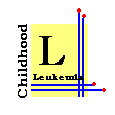

In 1827, a 63-year-old florist had died due to unknown causes. This man became ill with a swelling in the abdomen, fever and weakness and he died soon after admission to the hospital. At the time of autopsy, he was found to have an enormous liver and spleen - the latter weighing some 10 pounds, which is heavier than a newborn baby. His physician described this man's blood's strange appearance as "....like gruel....resembling in consistency and colour the yeast of red wine.....one might have asked if it were not rather laudable pus, mixed with the blackish colouring matter than blood." This was the first accurate description of a case of leukaemia. Although Alfred Velpeau, the physician, had no idea what he was describing, he provided a record that guided other doctors.
Today, we know that leukaemia is the most common form of cancer in children. In recent years, the outlook for children with leuakaemia has imroved dramatically from 100% mortality forty years ago to more than 50% cure rate today.
Leukaemia is often treated, in the initial phase, with intensive chemotherapy to kill all cancer cells in the body. The patient may become sicker during treatment because of the high dosages of anticancer drugs used. After this initial treatment phase, radiation and additional drugs, used in lower doses, may be administered to ensure complete eradication of all leukaemic cells in the body.